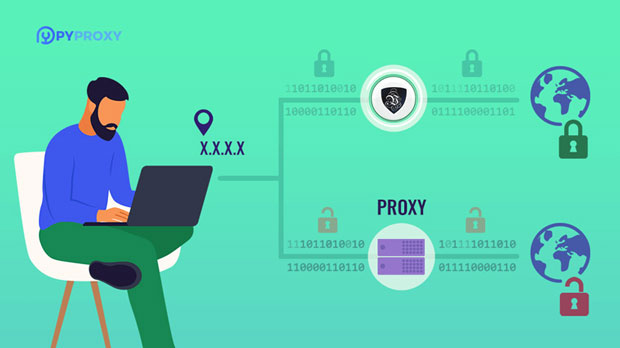Squid Proxy vs Py Proxy, Socks5 Proxy Compatibility Comparison in Browser Settings
In the world of proxy servers, different types offer distinct features and functionalities. Among them, Squid Proxy, py proxy, and socks5 proxy are widely used for their ability to anonymize internet traffic and provide users with enhanced security and access control. While these proxies serve a similar purpose, they differ significantly in terms of their setup, features, and compatibility with browsers. This article will compare Squid Proxy and Py Proxy in terms of their efficiency, setup, and use in browsers, along with a deep dive into the compatibility of Socks5 proxy in browser settings. By the end, you will have a clearer understanding of the best proxy for your browsing needs. 1. Introduction to Proxy ServersA proxy server acts as an intermediary between a user's device and the internet. It allows users to mask their IP addresses, bypass geographical restrictions, and enhance online privacy and security. While there are many types of proxies available, three of the most common are Squid Proxy, Py Proxy, and Socks5 Proxy. Each of these proxies operates differently and has varying compatibility with browsers.2. Squid Proxy OverviewSquid Proxy is an open-source caching and forwarding HTTP proxy server. It is one of the most widely used proxy servers for web traffic because of its caching capabilities, which help improve response times and reduce bandwidth usage. It supports HTTP, HTTPS, FTP, and more, making it a versatile choice for organizations needing reliable web traffic management. Squid also offers advanced access control features, enabling administrators to define rules based on IP addresses, URL patterns, and more.2.1 Setup and ConfigurationSetting up Squid Proxy typically requires more technical knowledge than some other proxies. It involves editing configuration files, adjusting network settings, and ensuring proper integration with other systems. While this might be a barrier for some users, the flexibility Squid offers in terms of control and customization makes it a strong option for businesses that require extensive proxy configurations.2.2 Browser CompatibilitySquid Proxy is compatible with a wide range of browsers, including Chrome, Firefox, Internet Explorer, and Safari. Since Squid primarily supports HTTP and HTTPS traffic, it integrates seamlessly with browsers that handle these protocols. However, users need to configure their browsers manually to route traffic through the Squid server. This involves setting the proxy address and port in the browser's network settings. While Squid Proxy works well with most browsers, users may face issues with certain web applications that rely on non-HTTP traffic, as Squid has limited support for protocols beyond HTTP/HTTPS.3. Py Proxy OverviewPy Proxy, on the other hand, is a Python-based proxy that offers a simpler and more flexible alternative to Squid. It is lightweight, easy to install, and supports various protocols like HTTP, HTTPS, and Socks5. One of the main selling points of Py Proxy is its ability to handle multiple protocols in a user-friendly manner. Unlike Squid, Py Proxy doesn’t require extensive configuration and can be quickly set up, making it an ideal solution for casual users or smaller businesses.3.1 Setup and ConfigurationThe setup for Py Proxy is relatively simple. It often requires little more than installing Python, running the proxy server, and configuring the browser or application to connect through it. Unlike Squid, Py Proxy does not require in-depth system configuration, which makes it more suitable for users who are less familiar with network administration. Py Proxy is often preferred by users who need quick, hassle-free proxy solutions.3.2 Browser CompatibilityPy Proxy is compatible with most modern browsers, such as Chrome, Firefox, and Edge. The setup process involves configuring the proxy settings in the browser to point to the Py Proxy server. Py Proxy supports various protocols, including HTTP, HTTPS, and Socks5, which means that it can handle more than just web traffic. This makes it a more versatile option for users who require additional functionality, such as accessing peer-to-peer (P2P) services or torrenting. However, Py Proxy may face performance issues when handling large-scale traffic, making it less ideal for heavy use cases compared to Squid.4. Socks5 Proxy OverviewSocks5 Proxy is a protocol designed to route internet traffic through a proxy server, offering higher levels of anonymity and privacy. Unlike HTTP proxies, which only handle web traffic, sock s5 proxies can handle any type of traffic, including email, FTP, and peer-to-peer services. This flexibility makes Socks5 ideal for users seeking comprehensive anonymity. Socks5 is known for its ability to bypass firewalls, unblock restricted content, and provide a high level of privacy.4.1 Setup and ConfigurationSetting up Socks5 proxies is relatively straightforward compared to Squid Proxy, though more complex than Py Proxy. Users must configure their browsers or applications to use the Socks5 server by entering the proxy address and port. Some browsers, such as Firefox and Chrome, allow users to configure Socks5 proxies directly within their network settings, while others may require third-party extensions or manual setup. While setup is relatively simple, users should ensure they have a reliable Socks5 provider, as performance can vary widely depending on the provider.4.2 Browser CompatibilitySocks5 Proxy is supported by most major browsers, including Firefox, Chrome, and Safari. However, users must ensure that their browser supports Socks5 protocols natively or through a plugin. Firefox offers built-in support for Socks5, while Chrome typically requires additional configuration or third-party extensions. Unlike HTTP proxies, Socks5 can handle a wide range of internet traffic, making it suitable for more than just web browsing. Its ability to handle multiple protocols ensures better privacy and security, particularly for users engaging in activities such as P2P file sharing or accessing restricted content.5. Comparing Squid Proxy, Py Proxy, and Socks5 Proxy in Browser SettingsWhile Squid Proxy, Py Proxy, and Socks5 Proxy all offer distinct advantages, they differ in terms of browser compatibility, ease of setup, and functionality.5.1 Ease of SetupPy Proxy is the easiest to set up, with a straightforward installation process that requires minimal configuration. Squid Proxy, however, requires more technical knowledge, and users must configure it through complex settings. Socks5 Proxy falls in between these two, offering a relatively simple setup but often requiring third-party tools or extensions in some browsers.5.2 Browser CompatibilityAll three proxies are compatible with major browsers, but the level of ease and functionality differs. Squid Proxy excels with HTTP and HTTPS traffic but may struggle with non-HTTP protocols. Py Proxy is versatile and supports HTTP, HTTPS, and Socks5 protocols, making it suitable for users who need more than just basic web browsing. Socks5, in comparison, is the most flexible, handling a wide range of internet traffic beyond just web protocols. However, some browsers require plugins or additional configuration for optimal performance.5.3 Privacy and AnonymityFor privacy and anonymity, Socks5 Proxy stands out, as it allows for the routing of all internet traffic, including email and file-sharing services. It offers superior privacy by hiding the user’s real IP address and enabling anonymous internet access. Squid Proxy, while offering solid privacy features, is primarily designed for web traffic and does not support the same range of protocols. Py Proxy offers a balance, providing anonymity for basic web browsing but lacking some of the advanced features that Squid and Socks5 offer.6. ConclusionChoosing the right proxy for your needs depends on several factors, including ease of setup, browser compatibility, and the level of anonymity required. Squid Proxy is best suited for businesses that need high-level customization and control, while Py Proxy is ideal for casual users who need a simple and effective solution. Socks5 Proxy, on the other hand, offers the best privacy and flexibility, making it suitable for users who require comprehensive anonymity and the ability to bypass various types of internet restrictions. Ultimately, the best choice depends on your specific needs and use case.
2025-03-03
























































